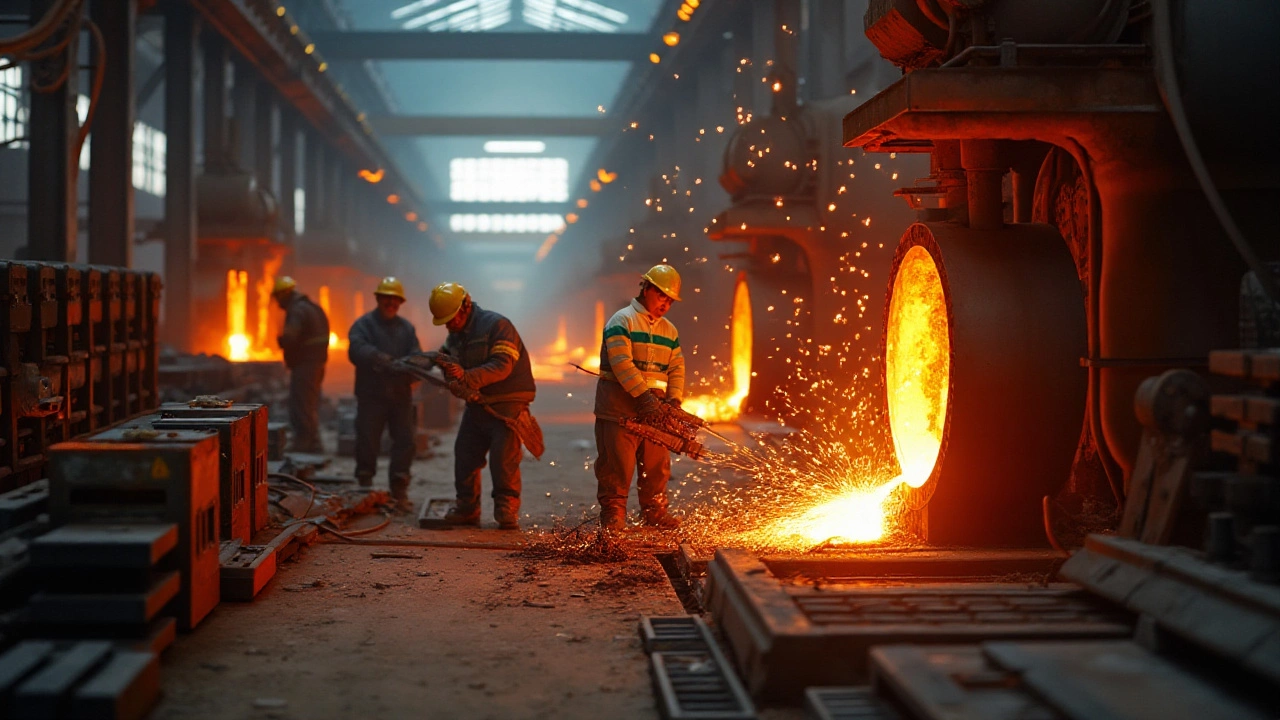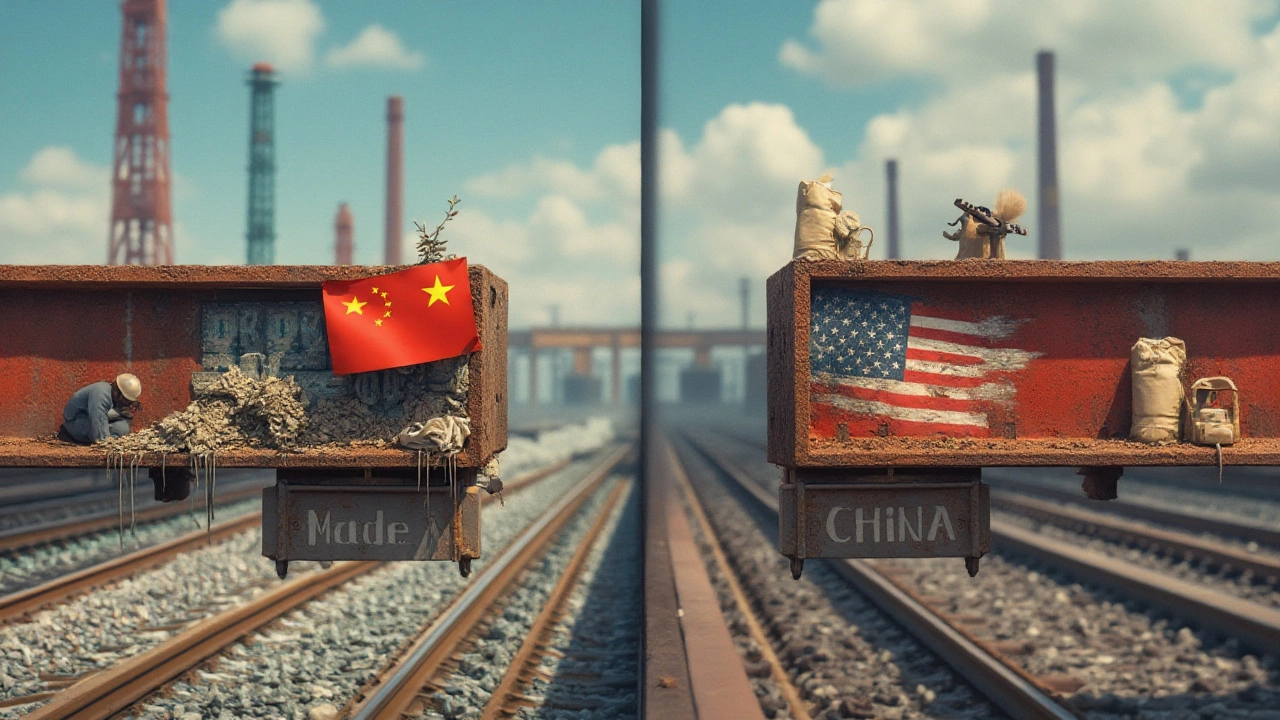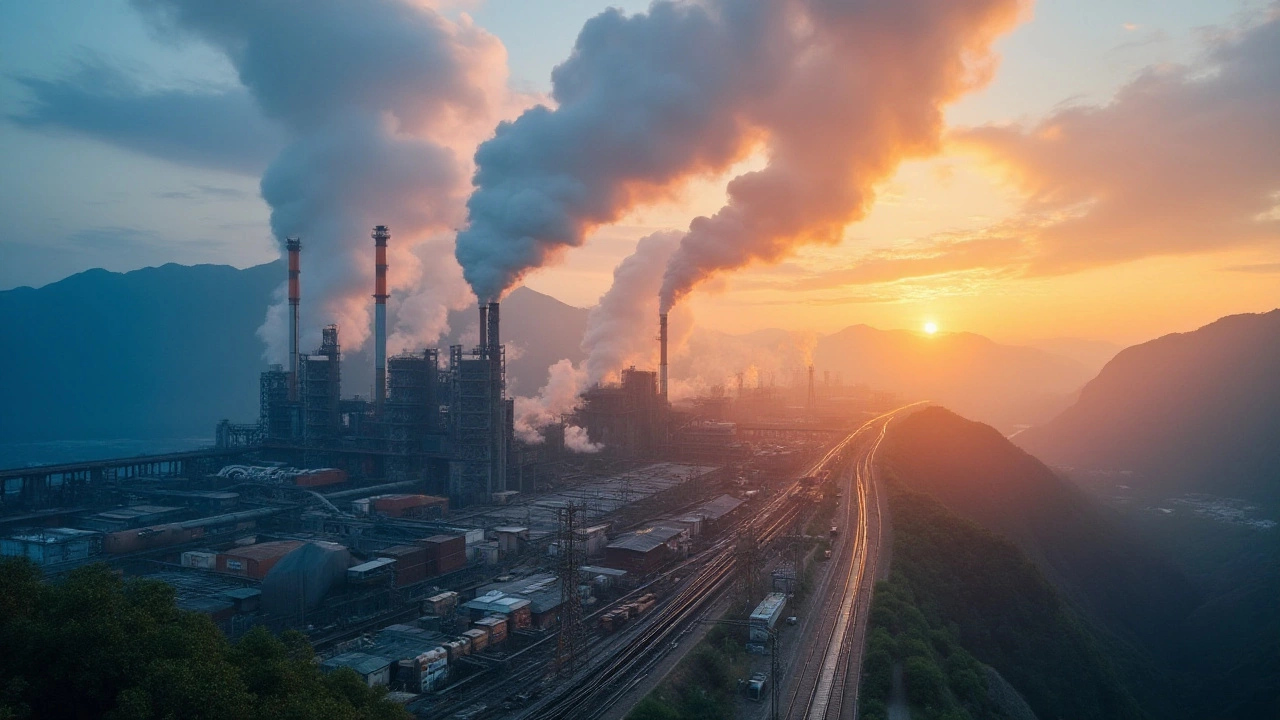The price difference between Chinese steel and American steel often raises eyebrows and questions, especially among those who rely on steel production and consumption. This discrepancy is not merely a coincidence; it's a complex web of variables that range from labor costs to government policies.
In China's case, the ability to produce steel at a lower cost involves multiple strategies and structures that have been developed over decades. It's a blend of precise manufacturing tactics, economic policies, and innovative logistics—all working in concert to lower expenses and boost production.
For stakeholders in steel industries worldwide, understanding why Chinese steel comes cheaper offers much more than just a pricing advantage; it reveals business strategies, global competition landscapes, and economic insights that carry significant strategic weight.
- Manufacturing Costs and Efficiency
- Government Influence and Subsidies
- Labor and Workforce Impacts
- Raw Materials and Supply Chain Logistics
- Economies of Scale
- Global Market Dynamics
Manufacturing Costs and Efficiency
The efficient production of Chinese steel owes much to its well-structured approach to manufacturing costs. The factors that trim down the cost are multifaceted, involving the seamless integration of modern advanced technical processes alongside traditional labor advantages. What makes China an exceptional player in the steel game is its ability to tap into expansive local resources, reducing reliance on expensive imports. Coupling this with moderate labor wages creates a cost-effective yet high-yielding manufacturing environment, crucial in underselling US steel.
In China, giant integrated steel mills operate with efficiency at their core, benefiting from continuous production cycles that minimize downtime and optimize output. The sophisticated planning, enmeshed with the latest technologies, ensures that waste is minimized and production lines run smoothly. Some factories employ cutting-edge automation to enhance precision and consistency, a step above labor-heavy tactics traditionally relied on by other countries. Additionally, Chinese steel manufacturers maintain a stringent focus on process enhancements, continuously refining methods to accrue energy savings and boost productivity. The existence of comprehensive strategies aimed at improving efficiency not only lowers manufacturing costs but also contributes to a more sustainable industrial model.
Technology and Innovation
Technology plays a transformative role in reducing production costs as well. Advanced machinery, combined with AI-driven analytics, enables real-time monitoring and adjustments, ensuring that production systems are not only efficient but remain adaptable to fluctuations in demand. This technological leverage is not universally available to all markets, giving China a significant edge. The Chinese government actively promotes domestic technological advancement, leading to innovations that enhance manufacturing agility and quality. Yet, this aggressive pursuit often outpaces what is seen in American factories, where innovation tends to align more with stability rather than rapid evolution.
As noted in a report by the World Steel Association, "China's steel production benefits from high industrial concentration and the ability to scale quickly, promoting efficiencies that are reflected in more competitive pricing."
Moreover, these innovative efforts are complemented by China’s strategic vision focuses on long-term industrial leadership. This approach encourages not only the adoption of best practices from around the world but also the development of indigenously driven solutions tailored to local challenges. The synergy between technological prowess and cost-effective operations makes for a potent combination that is hard to match. It is, therefore, not surprising that Chinese steel efficiently shores up its global standing by being accessible and competitively priced. This landscape teaches us the importance of investing in manufacturing technology as a front-line defense against exorbitant market costs.
Government Influence and Subsidies
The storytelling of China's steel industry's rise is incomplete without the chapter on government support. For decades, the Chinese government has provided substantial subsidies and strategic direction, making Chinese steel an almost unbeatable competitor on the global stage. These subsidies come in multiple forms, from direct financial aid to tax breaks and cheaper land access for steel manufacturers. With these measures, Chinese steel producers can keep operational costs far lower than many of their international counterparts, including those in the United States. This influence is not only financial but also involves policy decisions that align with the goal of becoming the world's leading steel producer. Policies are meticulously designed to spur growth, allow for competitive pricing, and often cushion the industry from economic downturns.
A significant factor has been the commanding role of state-owned enterprises (SOEs) in the Chinese steel sector. These SOEs have access to favorable loans and government-backed investments, allowing them to finance expansions and innovations that private companies elsewhere might struggle to achieve. The government's tight involvement means that, during periods of poor market performance, these enterprises receive support to avoid closure and even to keep production going. Such a safety net arguably leads to a surplus, with capacity often exceeding demand and driving prices down. This can disadvantage American producers who must operate with tighter margins and less room for error.
Impact of Tariff and Trade Policies
Chinese steel's affordability is also tied to its strategic international trade policies. The Chinese government enacts tariff measures and forms trade agreements that favor domestic production. This is exemplified by the recent tariffs imposed on foreign steel, making imported steel pricier within China while making exported Chinese steel more competitive abroad. Through these actions, Chinese authorities manage to protect their internal market and bolster their export standings. This careful juggling act ensures that Chinese steel manufacturers maintain their price edge on the global stage. While critics may argue that these subsidies amount to unfair trade practices, there's no denying their effectiveness in fueling China's industry growth. As noted by a spokesperson from the Global Trade Watch, "China's strategic subsidies have turned the global steel landscape in their favor, and the ripple effects are felt worldwide."
Arguably, these government policies not only provide immediate financial benefits but also cultivate an environment where continuous improvement and innovation can flourish. Because of this support, Chinese companies can experiment with low-cost production methods and enhance the manufacturing processes at scales that are often unimaginable to their western counterparts. This synergy of subsidies and strategic foresight showcases China's will to remain at the zenith of the steel manufacturing hierarchy, outpacing others through a formulaic combination of support and control. For those eyeing a slice of the global steel trade, understanding this dynamic is essential.

Labor and Workforce Impacts
When examining the Chinese steel industry's labor and workforce strategies, the scale of operations can't be overlooked. Unlike in the United States, China's labor force is vast, providing a significant pool of workers to power their steel industries. The relative cost of labor is a crucial factor. With regulatory frameworks that differ significantly from Western counterparts, particularly in the realm of minimum wage requirements and other worker-related expenses, Chinese steel enterprises can maintain their operations at a lower cost. As a result, this cost-effectiveness translates directly into more competitive pricing for Chinese steel on the global market.
Moreover, China's government plays an active role in labor training and education, ensuring that workers are not only plentiful but also skilled. Steel manufacturing plants benefit from initiatives aimed at enhancing technical skills, which boosts productivity and maintains quality despite lower operational costs. This emphasis on workforce development enables a sustainable production capability that rivals more expensive Western counterparts.
In contrast, the United States has stringent labor regulations that companies must adhere to, including higher minimum wages, comprehensive benefit requirements, and safety standards. These factors mean that producing steel in the U.S. incurs higher costs, which are subsequently passed down to the consumer in the form of higher prices. Often, U.S. steel companies face challenges such as worker shortages and increasing competition from overseas markets where operations might not be compelled by the same regulatory requirements.
"China's ability to provide skilled yet inexpensive labor is a game-changer. The focus on technical education and training ensures a pipeline of workers that bolsters their industrial capacity," notes industrial economist John Parker.
The efficiency of steel manufacturing in China also capitalizes on streamlined logistics and workflow processes. By optimizing workforce allocation, Chinese companies can distribute tasks more effectively, reducing waste and maximizing productivity. This approach not only lowers costs but also enhances delivery times, making Chinese steel an attractive option for international buyers looking for reliable supply chains.
These labor enhancements reflect broader economic strategies where sustaining low-cost yet effective production capabilities gives China a competitive edge in the global marketplace. It's noteworthy that some Chinese steel companies operate multiple integrated facilities that allow for seamless transfer of resources and labor adjustments as demand fluctuates, minimizing downtimes and financial setbacks.
Raw Materials and Supply Chain Logistics
When it comes to producing Chinese steel at costs that compete on a global scale, supply chain logistics play a pivotal role. The geographic positioning of China gives it unique access to the raw materials necessary for steel manufacturing—iron ore and coal being the most crucial. China houses some of the world's largest iron ore deposits, significantly driving down the initial costs associated with acquiring such necessary materials. Additionally, a vast domestic network of railways and roads facilitates the efficient transport of these raw materials to factories, minimizing logistical costs that otherwise burden foreign competitors.
China's strategic investments in infrastructure not only benefit local businesses but extend their effects beyond the borders. The development of robust seaports and extensive rail lines enables swift and cost-effective movement of materials domestically and internationally. This sophisticated logistics network reduces delays and downtime, allowing Chinese steel producers to remain agile and responsive to market demands. The seamless movement from mines to manufacturing plants is a well-orchestrated dance that many economies aim to emulate, but few do with China's efficiency.
Furthermore, China's inclination towards vertical integration has led many steel companies to control the entire supply chain from raw material extraction to the manufacturing processes. This control limits dependency on external suppliers, reducing unforeseen disruptions and allowing for economies of scale that pass cost benefits directly to consumers. An impressive element of this system is the ability of these companies to adjust outputs dynamically in response to international price fluctuations and trade policies.
The geopolitical landscape also plays a role; with China's proactive stance in securing long-term mineral import agreements with other nations, the country insulates itself from volatile resource markets. By diversifying its raw material sourcing and strengthening partnerships globally, China has bolstered the reliability and sustainability of its supply chains. As of 2022, China's strategic reserves and international partnerships have positioned it to withstand fluctuating market forces, ensuring stability in steel production costs.
Supply Chain Innovations
In recent years, technological strides in logistics have transformed the way Chinese steel reaches global markets. Automation, data analytics, and AI-driven supply chain optimizations have allowed for unprecedented levels of efficiency. These technologies not only forecast demand with greater accuracy but also manage inventory across multiple nodes in the supply chain. By integrating such innovations, Chinese companies maintain a competitive edge while minimizing waste and enhancing profit margins.
"China's investment in the Belt and Road Initiative has opened new corridors for trade, drastically reducing the lead times for their steel manufacturing exports," asserts trade analyst Jonathan Li. The impact of this initiative extends beyond mere trade benefits, fostering international relationships that reinforce China's position as a dominant figure in the global steel market.

Economies of Scale
The phrase "economies of scale" often pops up when we discuss why Chinese steel tends to be cheaper compared to other global markets. Essentially, this concept entails the cost advantages that enterprises obtain due to the scale of their operations, with cost per unit of output generally decreasing with increasing scale as fixed costs are spread out over more units of output. It’s a principle that Chinese steel manufacturers have mastered through decades of development and strategic investments. By producing steel on an immense scale, Chinese companies significantly reduce per-unit costs, allowing them to offer lower prices without sacrificing profitability.
China's steel manufacturing prowess didn’t develop overnight. As the world's leading steel producer, the country has continuously expanded its plants and infrastructure to support massive production outputs. Large-scale manufacturing not only helps in spreading out the fixed costs but also allows for the deployment of advanced technologies and efficient processes that would otherwise be financially burdensome at a smaller scale. A notable example is the introduction of cutting-edge blast furnace technologies that significantly ramp up daily production levels while concurrently minimizing resource consumption and wastage. Such improvements translate directly into cost reductions for both production and operation, further lowering the price tag on Chinese steel.
Churning out such massive quantities requires other supporting pillars, such as logistics and supply chain management. Often, Chinese steel plants are strategically located near essential resources like coal and iron ore mines or alongside key transportation hubs such as ports. By reducing transportation costs of raw materials, Chinese steel companies can save an appreciable amount, which benefits their bottom line. Furthermore, the integration of supply chain operations into a cohesive system ensures a smooth flow from mining to manufacturing to distribution, again cutting down costs considerably. "Operating on such an enormous scale allows us to optimize every facet of production, transportation, and sales," said a senior official at a leading Chinese steel company during an industry summit last year.
"The real beauty of economies of scale in the steel industry comes from the ability to absorb fluctuations in demand while maintaining operational efficiency," noted an industry analyst in a report by the World Steel Association.
When examining Chinese steel production through the lens of economies of scale, it becomes apparent that the competitive edge doesn’t rest solely on production might. There’s an underlying synergy between technology, logistics, strategic location, and production volume that works harmoniously to create cost-competitive Chinese steel. The by-product of such harmony has been an unparalleled global price advantage that few other countries can match. Looking ahead, as new innovations and technologies become available, we can expect this system to undergo fine-tuning—continuing to maximize efficiency and reinforce China's standing in the global steel market.
Global Market Dynamics
The global steel market has many moving parts, with Chinese steel standing at the forefront of numerous discussions due to its significant influence. One of the remarkable elements in this dynamic is China's staggering production capacity, which far exceeds that of any other nation. In recent years, China has contributed more than half of the world's steel output, a fact that underscores its pivotal role in global supply chains. This sheer volume enables Chinese manufacturers to dominate price settings on the international stage and inevitably impacts the pricing strategies of US steel producers.
Part of the reason for this dominance lies not only in the availability of resources and labor but also in strategic governmental policies supporting the steel industry. The Chinese government often provides subsidies and financial assistance to steel plants, allowing them to operate at lower costs. This public support reduces the financial burden on companies cutting into costs, allowing them to offer more competitive prices. These advantages find reflection in market share as buyers worldwide often seek the most budget-friendly options, facilitating China's hold over various international markets.
"China's ability to produce too much or too little steel largely defines the prices globally," says David Collins, an industry analyst at Global Metals Group, highlighting China's influence on market trends.
A crucial component of the global steel economy is logistics. China's geographical position allows it to expedite transporting finished goods across Asia, Europe, and even the Americas. Many factories are strategically located near ports, lowering logistical expenses and allowing for swift, cost-effective delivery. This logistical framework is often envied by competitors in the West, where infrastructure may involve more complexity.
Analyzing economic trade policies further illuminates how the global steel industry operates. In various instances, tariffs and international trade agreements play a massive role in market dynamics. Recent tariffs imposed by different nations on steel imports and exports have sparked shifts in trade flows and pricing strategies. However, China's alliances and bilateral agreements help it navigate these tariffs more effectively, ensuring Chinese steel's accessibility in many regions despite potential trade obstacles.
It's also worth noting that due to climate concerns, many global steel producers face pressure to adopt environmentally friendly processes. Though often seen as an added expense, China has invested heavily in research and innovation to develop green steel manufacturing techniques. These investments might not yet balance economically, but they have the potential to alter cost structures in the future, potentially maintaining China's edge in steel production.
Overall, the world's steel market dynamics illustrate a complex picture influenced by production capabilities, governmental intervention, geographic logistics, and evolving trade policies. With China at the lead, it is a competitive field where each participant must keenly observe and adapt to changing variables to stay relevant.
